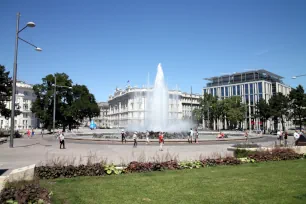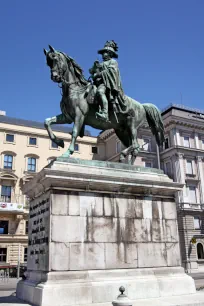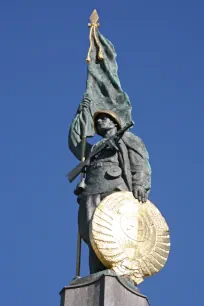Schwarzenbergplatz is a vast square situated near the Ringstraße. There are several sights at the square including a fountain, a Soviet monument and a statue of the prince after whom the square was named.

Unfortunately, the vast square is intersected by tram rails and busy roads, effectively dividing it into a number of unattractive traffic islands. Nonetheless, the square sees its fair share of visitors, if only because it lies along the route from the city center to the Belvedere Palace. During the nineteenth century Schwarzenbergplatz was one of the most prestigious addresses in the city and aristocrats erected plenty of stately buildings around the square.



Schwarzenberg
The square is named after Prince Karl Philipp of Schwarzenberg, a descendant of one of the most powerful aristocratic families in Bohemia and Central Europe in general. As commander in chief of the allied army, Karl Philipp was instrumental in the defeat of Napoleon’s army at the Battle of Leipzig in 1813 and even managed to capture the city of Paris the following year, which led to the abdication of Napoleon I.
The Austrian hero is honored with the Schwarzenberg Monument, an equestrian statue at the north of the square, installed here in 1867.
Hochstrahlbrunnen
The main attraction of the square is the monumental fountain located at the southern end of Schwarzenbergplatz. Known as Hochstrahlbrunnen (high jet fountain), it was built in 1873 to celebrate the completion of Vienna’s water supply system. Anton Gabrielli, the head of the company responsible for the project, personally funded the construction of the fountain.
Three hundred and sixty-five small jets at the edge of the basin, one for each day in the year, surround seven islands with jets symbolizing the seven days of the week. Twelve larger jets represent the months of the year, twenty-four more represent the hours of the day, and thirty other jets account for the days in the month. The largest, central jet represents the year. The fountain is especially beautiful at night, when it is illuminated with floodlights, first installed in 1906.
Red Army Memorial
Right behind the Hochstrahlbrunnen is the Denkmal der Roten Armee (Red Army Memorial), locally known as the Russendenkmal (Russian memorial). The memorial was erected in 1946 by the Soviet Army, which occupied a sector of the city until 1955. Before that year, a T-34 tank accompanied the monument.

The memorial consists of a semicircular colonnade with a twenty-meter-tall (66 ft.) central column topped with a monumental, twelve-meter-tall statue of a Soviet soldier. It is designed in the typical rigid and solemn style which was commonly employed by the Soviet army. The monument is very similar to other memorials erected at the time by the Soviet army in cities like Berlin and Budapest.
Schwarzenberg Palace
To the south of Schwarzenberg Square lies the beautiful Baroque Schwarzenberg Palace, constructed between 1697 and 1714 after a design by Johann Lukas von Hildebrandt. The palace is now occupied by a hotel and restaurant, and the Swiss embassy is housed in one of the palace’s wings. Unfortunately, both the palace and the gardens of the Schwarzenberg Palace, which border the Belvedere garden, are closed to the public.
French Embassy Building

One of the most interesting buildings along Schwarzenbergplatz is the home of the French Embassy, built between 1904 and 1912 to plans by the French architect Georges Chedanne, who is better known for his design of the Galeries Lafayette in Paris. The building, designed in Art Nouveau, was unlike anything the Viennese had ever seen, and they likened it to an Oriental building, which led to the rumor that the French had accidentally used the design for the embassy in Istanbul.
- Next: Am Hof
- More Sights & Attractions in Vienna

